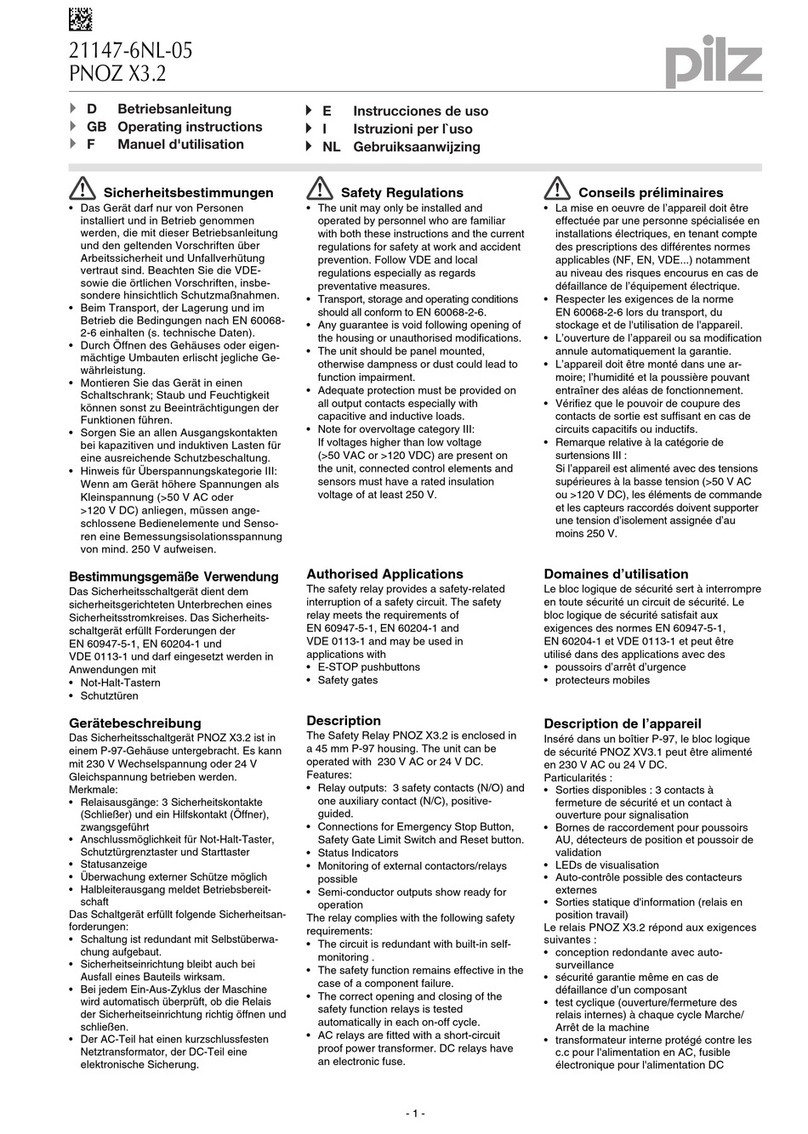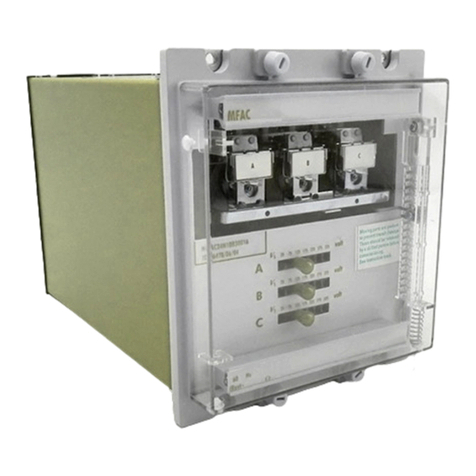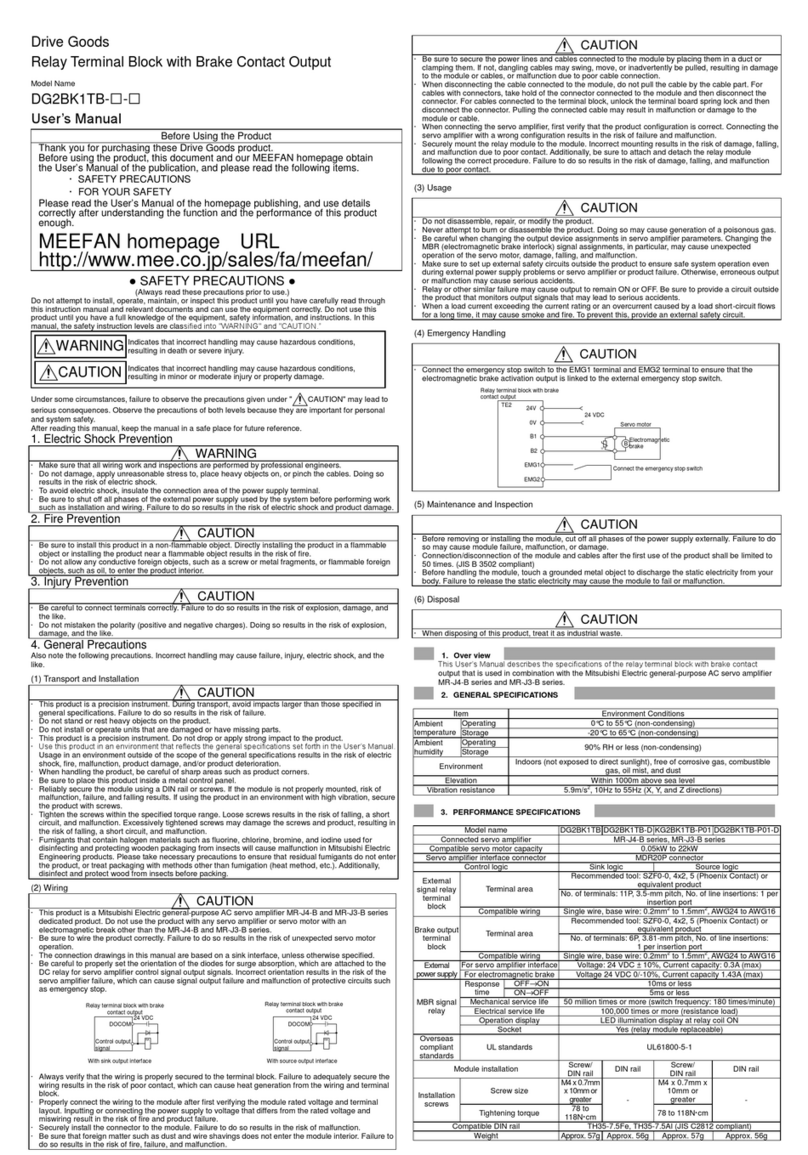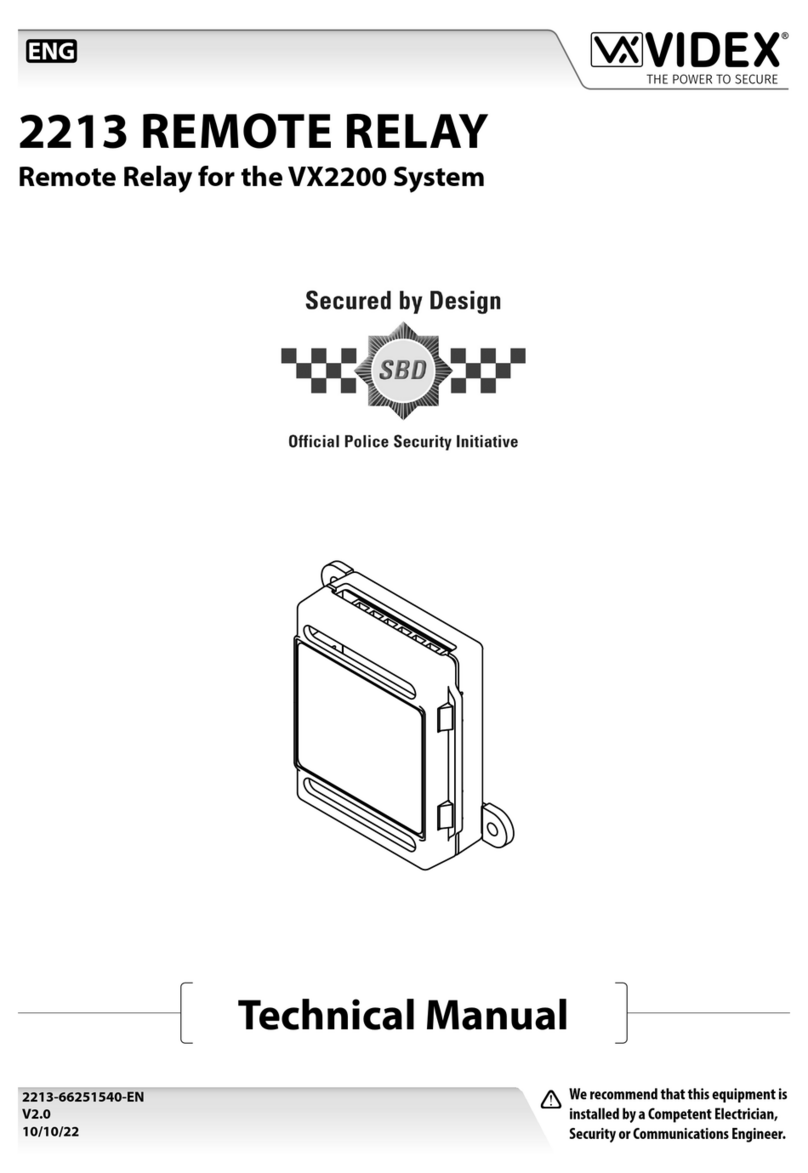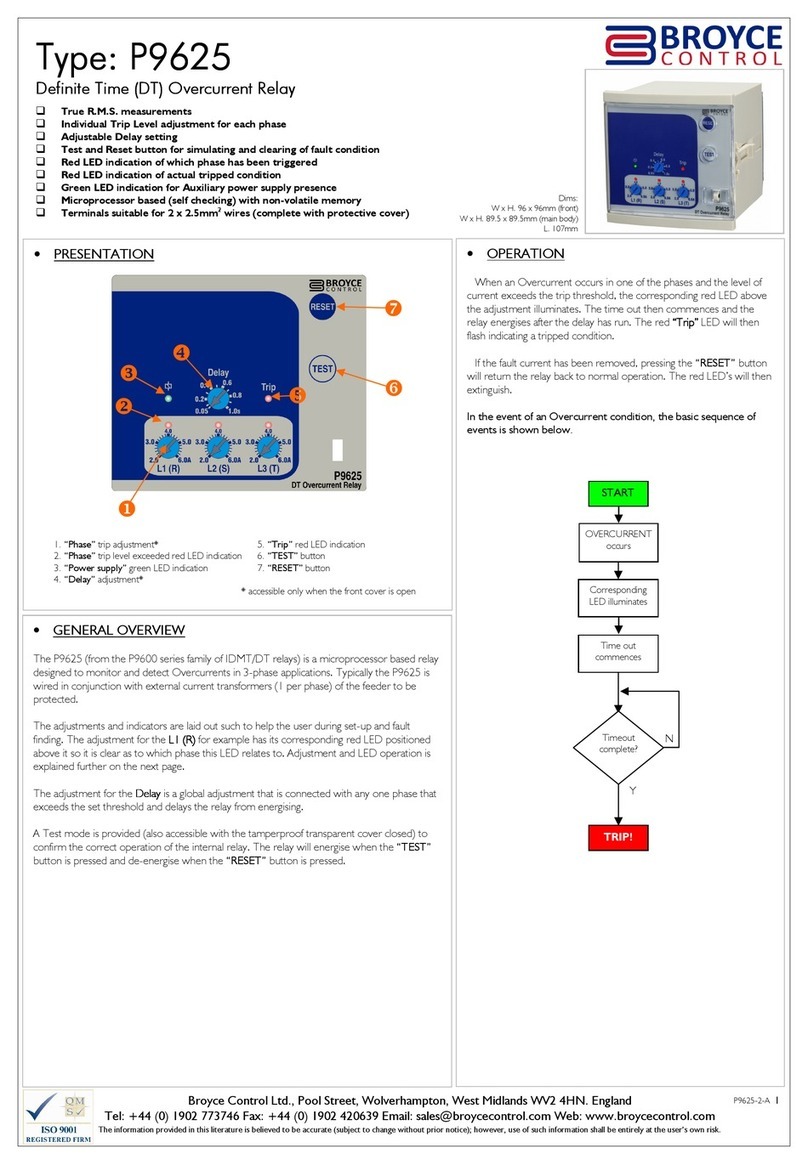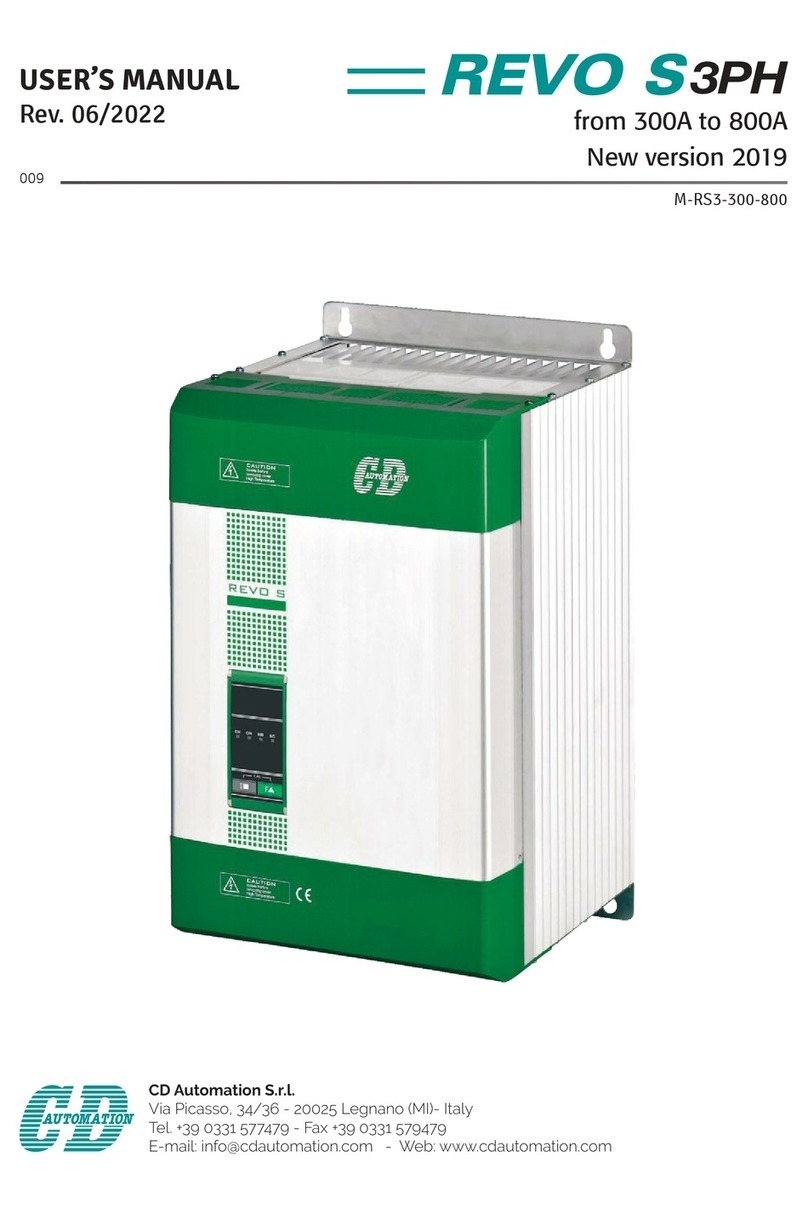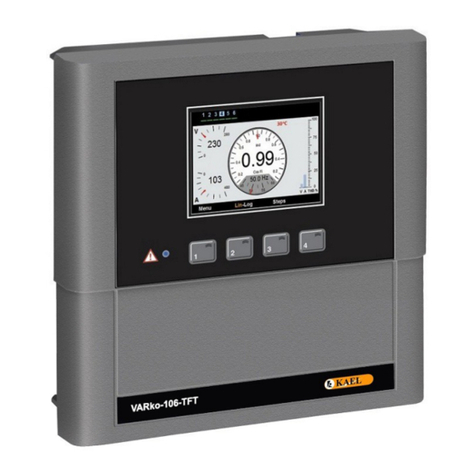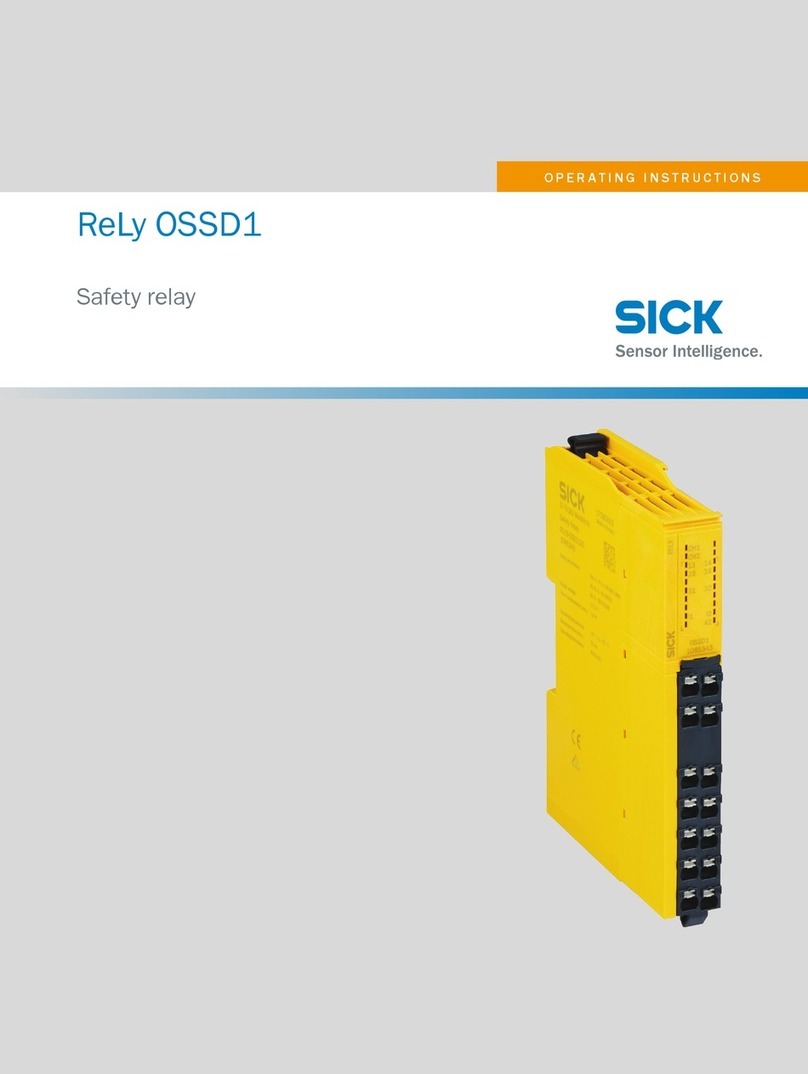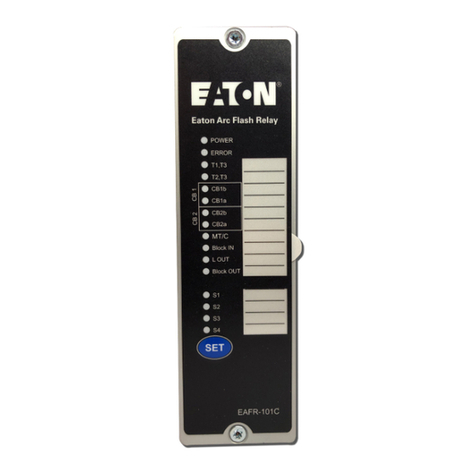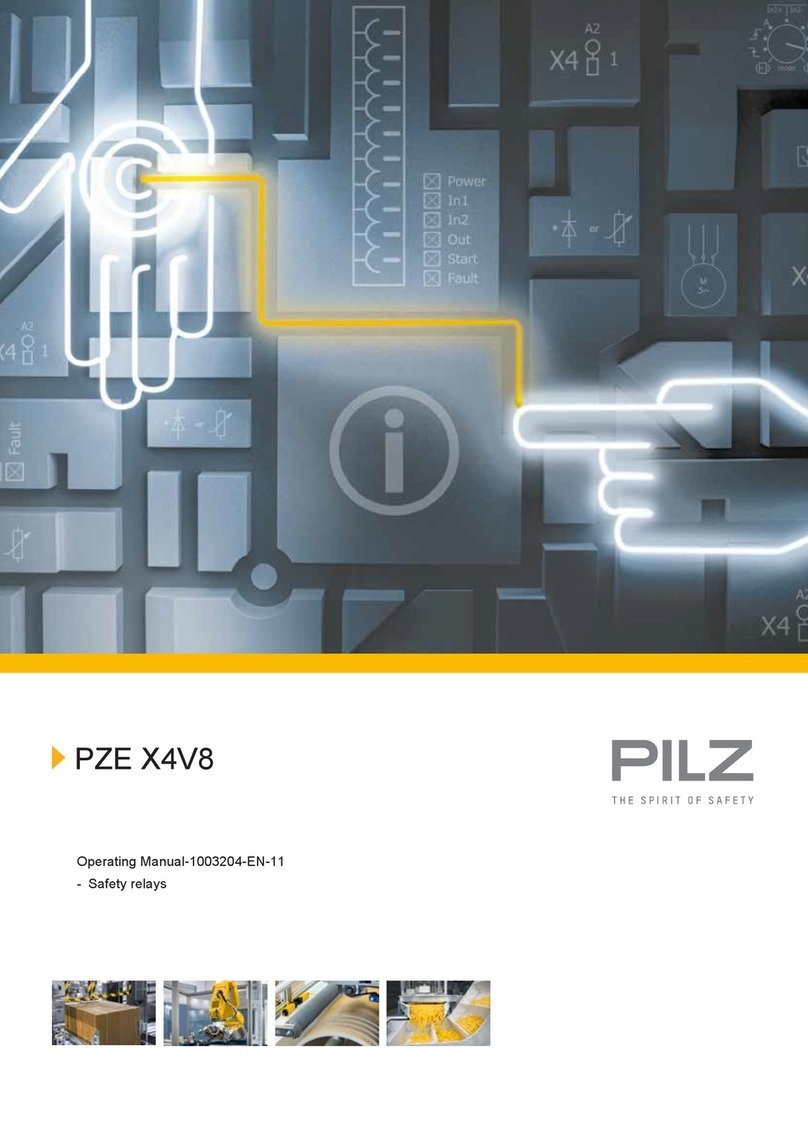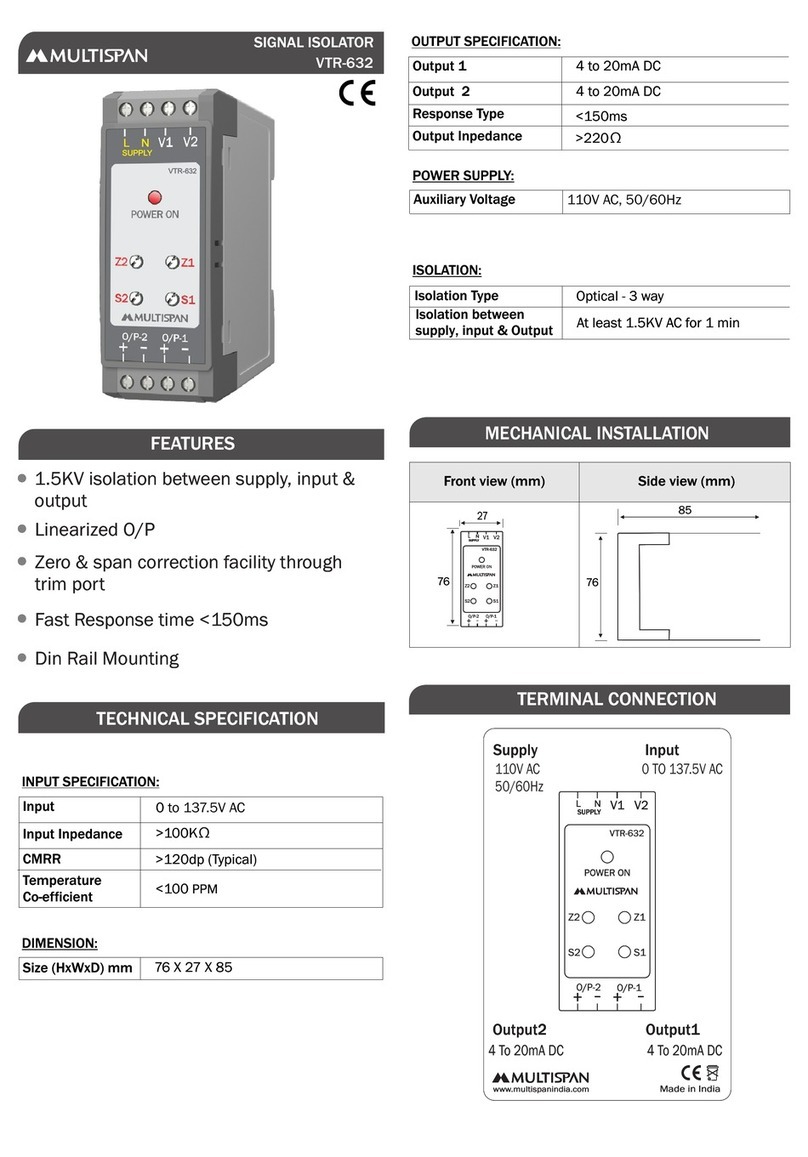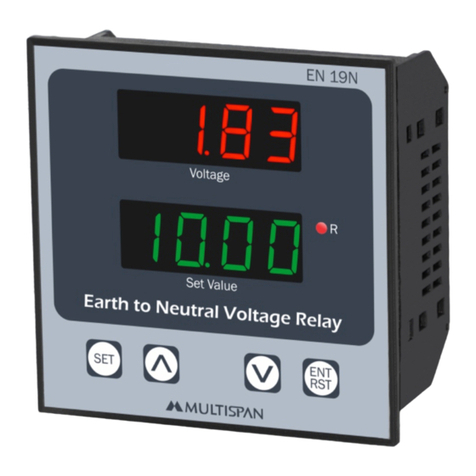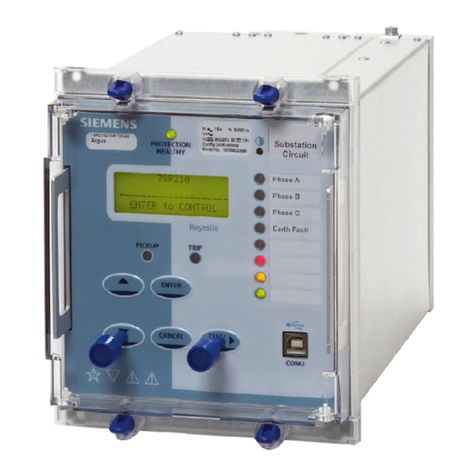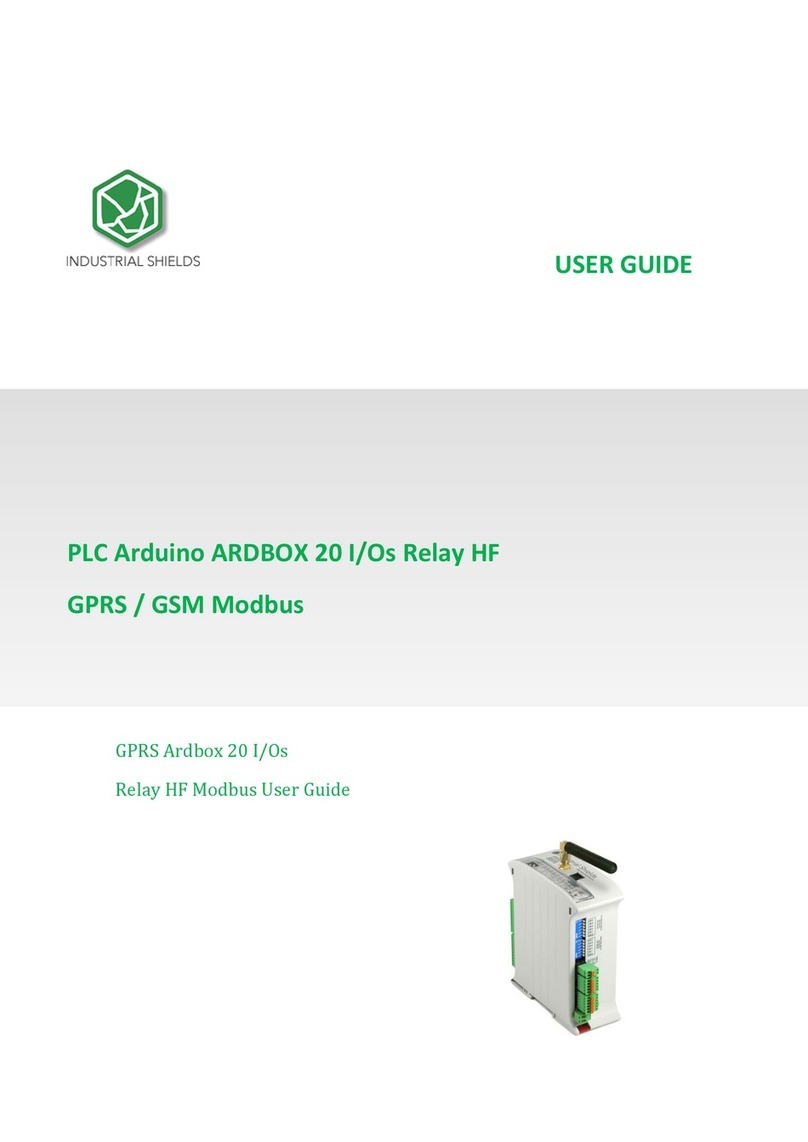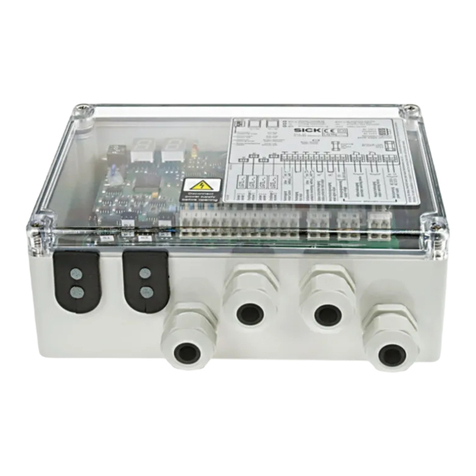BECKWITH ELECTRIC Syncrocloser M-3410A User manual

Instruction Book
M-3410A Intertie/Generator
Protection Relay

M-3410A
COM 1
INTERTIE / GENERATOR
PROTECTION
BECKWITH
ELEC T RIC CO. INC.
R
CUR. UNBALANCE 46
OVERCURRENT 51N/51V
DIRECTIONAL PWR 32
LOSS OF FIELD 40
VOLT. UNBALANCE 4
GROUND UV 2 G
PHASE UV 2
Mad e in U.S.A. OUTPUT 1
60FL FUSE LOSS
59/59I PHASE OV
59G GROUND OV
81 O/U FREQUENCY
OSC TRIGGER
DIAGNOSTIC
RELAY OK
RESET
TARGET/OUTPUT
OUTPUT 2
Intertie/Generator
Protection Relay
M-3410A
PROTECTION
• Available in four different Mounting configurations
• Facilitates standardization for small/medium intertie and generator
protection applications
• Microprocessor-based relay provides 15 protective relay functions, including
Sync-Check, 2 programmable outputs and 2 programmable inputs
• Relay voltage inputs can be directly connected (no VT required) for voltages
480 V or less
• Local and remote serial communications (MODBUS protocol) capability for
monitoring and control functions
Integrated Protection System®
59/59I PHASE OV
OUTPUT 2
RELAY OK
DIAGNOSTIC
59G GND OV
81 O/U FREQ
60FL FUSE LOSS
OSC TRIGGER
LOSS OF FIELD 40
PROTECTION
ELEC T RIC
BECKWITH
Mad e in U.S.A.
CO. INC.
INTERTIE /
GENERATOR
M-3410A
COM 1
OVERCURRENT
OUTPUT 1
VOLT. UNBAL. 4
51N/51V
CUR. UNBAL. 46
GND UV 2 G
DIR PWR 32
PHASE UV 2
TARGET/OUTPUT
RESET
R
M-3410A Vertical Panel (Optional)
M-3410A Horizontal Panel (Optional)
COM 1
BECKWITH
EL ECT RIC
INTERTIE / GENERATOR
PROTECTION
TARGET/OUTPUT
RESET
Mad e in U.S.A.
CO. INC.
M-3410A
R
CURRENT UNBALANCE 46
PHASE UNDERVOLTAGE 27
GROUND UNDERVOLTAGE 27G
DIRECTIONAL PWR 32
LOSS OF FIELD 40
OVERCURRENT 51N/51V
VOLTAGE UNBALANCE 47
OUTPUT 1
OSC TRIGGER
59/59I PHASE OVERVOLTAGE
1 OVER/UNDER FREQUENCY
60FL FUSE LOSS
59G GROUND OVERVOLTAGE
OUTPUT 2
RELAY OK
DIAGNOSTIC
M-3410A Standard Panel

–2–
M-3410A Intertie/Generator Protection Relay
Protective Functions
• Sync-check with Phase Angle, ΔV and ΔF with dead line/dead bus options (25)
• Phaseundervoltage(27)protection
• Groundundervoltage (27G)protection
• Dual-setpoint, single or three phase, directional power detection that can be selected as over/
under power protection (32)
• Dual-zone, offset-mho loss-of-field for generator protection (40)
• Sensitive negative sequence overcurrent protection and alarm (46)
• Negative sequence overvoltage (47)
• Inverse time neutral overcurrent (51N)
• Phase overcurrent with voltage restraint/control (51V) protection
• Phase overvoltage (59) protection
• Ground overvoltage (59G) protection
• Peak overvoltage (59I) protection
• VT fuse-loss detection and blocking (60FL)
• Reconnect enable for intertie protection (79)
• Four-step over/under frequency (81) protection
Standard Features
• 2 programmable outputs, 2 programmable inputs, and 1 self-test output
• Oscillographic recording (COMTRADE file format)
• Time-stamped sequence of events recording for 32 events
• Metering of Voltage, Current, real and reactive Power, Power Factor, Frequency, and Positive
Sequence Impedance
• One RS-232 port (COM1) on front and one RS-232 or 485 port (COM2) on rear
• M-3810A IPScom®For WindowsTM Communications Software
• M-3811A IPScom For Palm OS®Communications Software
• MODBUS protocol
• Supports both 50 and 60 Hz applications
• Accepts 1A or 5 A rated CT inputs
• Relay voltage inputs can be directly connected (no VT required) for voltages O480 V ac
• Continuous Self-Diagnostics
Optional Features
• M-3801D IPSplot®
PLUS
Oscillograph Analysis Software
• Horizontal and Vertical panel mount versions available (see Figures 7, 9 and 10)
• Standard 19" Rack Mount Available (See Figure 8)
• SurfaceMount Version available(See Figure 11)
• AdapterPlate available forM-0290 and M-0296Pride protection relay replacement

–3–
M-3410A Intertie/Generator Protection Relay
Values in parentheses apply to 1 A CT secondary rating.
PROTECTIVE FUNCTIONSPROTECTIVE FUNCTIONS
PROTECTIVE FUNCTIONSPROTECTIVE FUNCTIONS
PROTECTIVE FUNCTIONS
DeviceDevice
DeviceDevice
Device SetpointSetpoint
SetpointSetpoint
Setpoint
NumberNumber
NumberNumber
Number FunctionFunction
FunctionFunction
Function RangesRanges
RangesRanges
Ranges IncrementIncrement
IncrementIncrement
Increment AccuracyAccuracy
AccuracyAccuracy
Accuracy
Sync Check
Phase Angle Window 0° to 90° 1° 1°
Upper Voltage Limit 100.0 to 120.0%* 0.1% 0.5 V or 0.5%
Lower Voltage Limit 70.0 to 100.0%* 0.1% 0.5 V or 0.5%
Delta Voltage Limit 1.0 to 50.0%* 0.1% 0.5 V
Delta Frequency Limit 0.001 to 0.500 Hz 0.001 Hz 0.001 Hz or 5%
Sync Check Time Delay 1 to 8160 Cycles 1 Cycle
Dead Voltage Limit 0.0 to 50.0%* 0.1% 0.5 V or 0.5%
Dead Time Delay 1 to 8160 Cycles 1 Cycle 2 Cycles
* Of nominal voltage.
Sync Check may be operated as a stand-alone function or supervised by 79 (reconnect). Various
combinations of input supervised hot/dead closing schemes may be selected. This function can only be
enabled in line-to-line VT configuration and when functions 27G and 59G are not enabled.
Phase Undervoltage
Pickup #1, #2 4 to 100%* 0.1% 0.5 V or 0.5%
Time Delay #1, #2 1 to 8160 Cycles 1 Cycle 2 Cycles**
* Of nominal voltage.
** When DFT is selected, the time delay accuracy is
2 cycles. When RMS magnitude is selected, an
additional time delay from 0 to +20 cycles may occur.
Ground UndervoltageGround Undervoltage
Ground UndervoltageGround Undervoltage
Ground Undervoltage
Pickup 4 to 100%* 1 % 0.5 V or 0.5%
Time Delay 1 to 8160 Cycles 1 Cycle 2 Cycles
* Of nominal voltage, maximum of 600 V.
This function can only be enabled when the relay is configured in line-to-line VT and the 25 function is not
enabled.
Directional Power
Pickup #1, #2 –3.00 to +3.00 PU 0.01 PU 0.02 PU or 2%*
Time Delay #1, #2 1 to 8160 Cycles 1 Cycle 2 Cycles
The per-unit pickup is based on nominal VT secondary voltage and nominal CT secondary current settings for
currents less than 14 A (2.8 A). This function can be selected as overpower or underpower in the forward
direction (positive setting) or reverse direction (negative setting). This function can also be selected for single
phase detection for line-to-ground VT.
Minimum sensitivity of 100 mA for 5 A CT (real component of current).
* Accuracy applies for a nominal current range of 2.5 A to 6 A (5 A CT) or 0.5 A to 1.5 A (1 A CT).
25
27
32
27G

–4–
M-3410A Intertie/Generator Protection Relay
PROTECTIVE FUNCTIONS (PROTECTIVE FUNCTIONS (
PROTECTIVE FUNCTIONS (PROTECTIVE FUNCTIONS (
PROTECTIVE FUNCTIONS (
contcont
contcont
cont
.).)
.).)
.)
DeviceDevice
DeviceDevice
Device SetpointSetpoint
SetpointSetpoint
Setpoint
NumberNumber
NumberNumber
Number FunctionFunction
FunctionFunction
Function RangesRanges
RangesRanges
Ranges IncrementIncrement
IncrementIncrement
Increment AccuracyAccuracy
AccuracyAccuracy
Accuracy
Loss-of-Field (dual-zone offset-mho characteristic)
Circle Diameter #1, #2 0.01 to 3.00 0.01 PU 0.01 PU or 5%**
Offset #1, #2 –2.0 to 2.0 0.01 PU 0.01 PU or 5%**
Time Delay #1, #2 1 to 8160 Cycles 1 Cycle 2 Cycles
Voltage Control 4 to 100%* 0.1% 0.5 V or0.5%
(positive sequence)
Directional Element Fixed at –13° — —
* Of nominal voltage.
** Accuracy applies for a nominal current range of 2.5 A to 6 A (5 A CT) or 0.5 A to 1.5 A (1 A CT).
Negative Sequence OvercurrentNegative Sequence Overcurrent
Negative Sequence OvercurrentNegative Sequence Overcurrent
Negative Sequence Overcurrent
Definite Time
Pickup 3% to 300%* 1% 0.1 A or 0.5%**
(0.02 A or 0.5%)
Time Delay 1 to 8160 Cycles 1 Cycle 2 Cycles
Inverse Time
Pickup 3% to 100%* 0.1% 0.1 A or 3%**
(0.02 A or 3%)
Characteristic Curves Definite Time/Inverse Time/Very Inverse/Extremely Inverse/IEC/I22t=K
Time Dial Setting 0.5 to 11.0 0.1
0.05 to 1.1 (IEC) 0.01 3 Cycles or 10%**
1 to 95 (I2
2t=K) 1
For I2
2t=K Curve Only
Definite Maximum
Time to Trip 600 to 65,500 Cycles 1 Cycle 3 Cycles or 10%**
Reset Time (Linear) 4 minutes
(from threshold of trip)
* Of nominal current for currents less than 14 A (2.8 A).
** Accuracy applies for a nominal current range of 2.5 A to 6 A (5 A CT) or 0.5 A to 1.5 A (1 A CT), and for a
pickup of >5%.
Negative Sequence OvervoltageNegative Sequence Overvoltage
Negative Sequence OvervoltageNegative Sequence Overvoltage
Negative Sequence Overvoltage
Pickup #1, #2 4 to 100%* 0.1% 0.5 V or 0.5%
Time Delay #1, #2 1 to 8160 Cycles 1 Cycle 2 Cycles
* Of nominal voltage.
Inverse Time Residual OvercurrentInverse Time Residual Overcurrent
Inverse Time Residual OvercurrentInverse Time Residual Overcurrent
Inverse Time Residual Overcurrent
Pickup 0.50 to 6.00 A 0.1 A 0.1 A or 3%
(0.10 to 1.20 A) (0.02 A or 3%)
Characteristic Curves Definite Time/Inverse Time/Very Inverse/Extremely Inverse/IEC
Time Dial
Standard Curves #1–#4 0.5 to 11.0 0.1 3 Cycles or 10%
IEC Curves #1–#4 0.05 to 1.10 0.01
Values in parentheses apply to 1 A CT secondary rating.
47
46
51N
27
40

–5–
M-3410A Intertie/Generator Protection Relay
PROTECTIVE FUNCTIONS (PROTECTIVE FUNCTIONS (
PROTECTIVE FUNCTIONS (PROTECTIVE FUNCTIONS (
PROTECTIVE FUNCTIONS (
contcont
contcont
cont
.).)
.).)
.)
DeviceDevice
DeviceDevice
Device SetpointSetpoint
SetpointSetpoint
Setpoint
NumberNumber
NumberNumber
Number FunctionFunction
FunctionFunction
Function RangesRanges
RangesRanges
Ranges IncrementIncrement
IncrementIncrement
Increment AccuracyAccuracy
AccuracyAccuracy
Accuracy
Inverse Time Overcurrent, with Voltage Control or Voltage RestraintInverse Time Overcurrent, with Voltage Control or Voltage Restraint
Inverse Time Overcurrent, with Voltage Control or Voltage RestraintInverse Time Overcurrent, with Voltage Control or Voltage Restraint
Inverse Time Overcurrent, with Voltage Control or Voltage Restraint
Pickup 0.50 to 12.00 A 0.01 A 0.1 A or 3%
(0.10 to 2.40 A) (0.02 A or 3%)
Characteristic Curve Definite Time/Inverse/Very Inverse/Extremely Inverse/IEC Curves
Time Dial 0.5 to 11.0 0.1 3 Cycles or 10%
0.05 to 1.10 (IEC curves) 0.01
Voltage Control (VC) 4.0 to 150.0%* 0.1% 0.5 V or 0.5%
or
Voltage Restraint (VR) Linear Restraint — —
* Of nominal voltage.
Phase Overvoltage
Pickup #1, #2 100 to 150%* 0.1% 0.5 V or 0.5%
Time Delay #1, #2 1 to 8160 Cycles 1 Cycle 2 Cycles**
* Of nominal voltage.
** When DFT is selected, the time delay accuracy is
2 cycles. When RMS magnitude is selected, an
additional time delay from 0 to +20 cycles may occur.
Ground Overvoltage
Pickup 4 to 150%* 1% 0.5 V or 0.5%
Time Delay 1 to 8160 Cycles 1 Cycle 2 Cycles
* Of nominal voltage.
This function can only be enabled when the relay is configured in line-to-line VT and the 25 function is not
enabled.
Peak OvervoltagePeak Overvoltage
Peak OvervoltagePeak Overvoltage
Peak Overvoltage
Pickup 100 to 150%* 1% 3%**
Time Delay 1 to 8160 Cycles 1 Cycle 3 Cycles
*Instantaneous voltage magnitude response; intended for ferroresonance protection.
**For fundamental (60 Hz/50 Hz) signal only. For distorted input signals, the accuracy degrades as the order
of the harmonic signal increases.
VT Fuse-Loss DetectionVT Fuse-Loss Detection
VT Fuse-Loss DetectionVT Fuse-Loss Detection
VT Fuse-Loss Detection
A VT fuse-loss condition is detected by using the positive and negative sequence components of
the voltages and currents. VT fuse-loss output can be initiated from internally generated logic or
from input contacts.
Time Delay 1 to 8160 Cycles 1 Cycle 2 Cycles
Reconnect Enable Time Delay
Time Delay 2 to 65,500 Cycles 1 Cycle 2 Cycles
Reconnect timer starts when all outputs designated as trip outputs reset.
79
60
FL
59I
59
51V
59G

–6–
M-3410A Intertie/Generator Protection Relay
81
PROTECTIVE FUNCTIONS (PROTECTIVE FUNCTIONS (
PROTECTIVE FUNCTIONS (PROTECTIVE FUNCTIONS (
PROTECTIVE FUNCTIONS (
contcont
contcont
cont
.).)
.).)
.)
DeviceDevice
DeviceDevice
Device SetpointSetpoint
SetpointSetpoint
Setpoint
NumberNumber
NumberNumber
Number FunctionFunction
FunctionFunction
Function RangesRanges
RangesRanges
Ranges IncrementIncrement
IncrementIncrement
Increment AccuracyAccuracy
AccuracyAccuracy
Accuracy
Over/UnderFrequency
Pickup #1, #2, #3, #4 50.00 to 67.00 Hz 0.01 Hz 0.03 Hz
(40.00 to 57.00 Hz*)
Time Delay #1,#2, #3, #4 2 to 65,500 Cycles 1 Cycle 2 Cycles or 0.01%
*This range applies to 50 Hz nominal frequency models.
The pickup accuracy applies to 60 Hz models at a range of 57 to 63 Hz, and to 50 Hz models at a range of 47
to 53 Hz. The accuracy is
0.15 Hz for a range of 52 to 57 Hz, and 63 to 67 Hz (for 60 Hz nominal) and 42 to
47 Hz and 53 to 57 Hz (for 50 Hz nominal).
Nominal SettingsNominal Settings
Nominal SettingsNominal Settings
Nominal Settings
Nominal Voltage 50 to 500 V* 1 V —
Nominal Current 0.50 to 6.00 A 0.01 A —
VT Configuration Line-Line/Line-Ground/Line-Ground-to-Line-Line**
Seal-in Delay 2 to 8160 Cycles 1 Cycle 1 Cycle or 1%
* Maximum measured range for (25), (59), (59G) and (59I) function settings is < 600 V.
** When line-ground-to-line-line is selected, the relay internally calculates the line-line voltage from the line-
ground voltages for all voltage-sensitive functions. When line-ground-to-line-line selection is applied, the
nominal voltage selection should be the line-line nominal voltage (not line-ground nominal voltage).

–7–
M-3410A Intertie/Generator Protection Relay
Description
The M-3410A Intertie/Generator Protection Relay is intended for the protection of the intertie between the
utility and dispersed generation. It is also suitable for the protection of synchronous and induction
generators. Communications and control features of the M-3410A are accomplished utilizing the M-3810A
IPScom®For WindowsTM Communications Software Package from a PC platform, or M-3811A IPScom For
Palm OS®running on a HandspringTM VisorTM or PalmTM Handheld.
Metering
The relay provides metering of voltages, currents, real power, reactive power, power factor, frequency and
positive sequence impedance.
Metering Accuracies are:
Voltage:0.5 V or 0.5%, whichever is greater (Range 0 to 600 V)
Current: 5 A rating, 0.1 A or 3%, whichever is greater (Range 0 to 14 A)
1 A rating, 0.02 A or 3%, whichever is greater (Range 0 to 2.8 A)
Power: 0.02 PU or 2%, whichever is greater
Frequency:0.03 Hz (from 57 to 63 Hz for 60 Hz models; from 47 to 53 Hz for 50 Hz models)
Oscillographic Recorder
The oscillographic recorder provides comprehensive data recording of all monitored waveforms, input
contacts and output contacts, storing up to 120 cycles of data. The total record length is configured for one
or two partitions. A programmable post trigger delay (5 to 95%) is incorporated to capture breaker
operation. The oscillograph is triggered either remotely using the serial interface, or designated status
input signals or M-3410A programmable output operations. Storage of oscillographic records is nonvolatile,
and will be retained even without power, as long as the on-board battery is healthy.
Oscillographic data can be downloaded using serial communication in Common Format For Transient
Data Exchange (COMTRADE) format as specified by IEEE Standard C37.111-1999.
Sequence of Events
A total of 32 nonvolatile events can be stored. The recorded information includes the function(s) operated,
the function(s) picked up, input/output contact status and time stamp. The events can be retrieved through
the communications port. After the 32nd event is stored, additional events result in the oldest event being
dropped (FIFO). The information is time-stamped to 1 ms resolution.
Calculations
Current and Voltage Values
: Uses discrete Fourier transform (DFT) algorithm on sampled (32 times per
cycle) voltage and current signals to extract fundamental frequency phasors for calculations. The 59/27
function, when set for RMS measurement, uses a time domain algorithm to calculate the voltage
magnitude.
Power Input Options
lanimoN egnaR nedruB
cdV42/21cdV63ot9AV5<
cdV84cdV57ot63AV5<
cdV521/caV021cdV/caV051ot58AV7<

–8–
M-3410A Intertie/Generator Protection Relay
Sensing Inputs
3 Voltage Inputs
: Rated nominal voltage of 69 V ac to 480 V ac, 60 Hz (50 Hz user configurable). Will
withstand600 Vcontinuous voltage. Sourcevoltages maybe line-to-groundor line-to-line connected.Phase
sequence ABC/ACB is selectable. Voltage transformer burden less than 0.25 VA at 120 V ac.
3 Current Inputs
: Rated current (IR) of 5.0 A or 1.0 A, 60 Hz (50 Hz user configurable). Will withstand 2 IR
continuouscurrentand30IRfor2seconds.Currenttransformer burdenislessthan0.75 VA at5Afor5A inputs,
0.3 VA at 1 A for 1 A inputs.
Control/Status Inputs
The control/status inputs, INPUT1 and INPUT2, can be programmed to block any of the M-3410A functions
and trigger the oscillograph recorder. The control/status inputs accept only dry contacts and are internally
wetted (9 V dc) by the relay's power supply. A minimum current of 1.3 mA is required to avoid spurious
triggeringof the input.
Output Contacts
The two programmable output relays, each with a contact are rated as per ANSI/IEEE C37.90-1989 for
tripping: make 30 A for 0.2 seconds. Available hardware configurations include two normally open (Option
B1), one normally open and one normally closed (Option B2), or two normally closed (Option B3) contacts.
The contacts will carry 8 A, break 6 A at 120 V ac, break 0.1 A at 125 V dc, inductive break 0.1 A. Also
provided is a self-test alarm output contact (form 'c') with a rating of 8 A at 120 V ac, 5 A at 30 V dc, 125 V
dc 0.15 A resistive, 0.1 A inductive.
Any of the M-3410A protective functions can be individually programmed to activate the two programmable
outputs.The user canconfigure the twoprogrammable outputs toeither energize orde-energize to issuean
outputcommand.
The outputs (excluding the self-test) can have two modes of operation, LATCHING and NORMAL. The
LATCHINGmode requires anoperator interventionto deactivatethe outputs afterthe conditionfor operation
has been removed. In the NORMAL mode, when the condition for tripping has been removed, the output(s)
will deactivate automatically after the corresponding seal-in timers have expired.
Target/Status Indicators and Controls
The RELAY OK LED reveals proper cycling of the microprocessor. The DIAGNOSTIC LED provides
indicationof theerror code(whenflashing). TheOSC TRIGGER LED indicatesthat theoscillographhas been
triggered. The remaining eleven LEDs are used to indicate which protective function(s) have been tripped.
OUTPUT 1 and OUTPUT 2 are used to indicate the status of the output contacts. The output LEDs will
illuminate when the output contact relays are tripped. The TARGET/OUTPUT RESET button resets the
target LEDs if the conditions causing the operation have been removed. Holding the TARGET/OUTPUT
RESET buttondisplays the presentpickup statusof the M-3410Afunctions. TheTARGET/OUTPUT RESET
button will deactivate the tripped output contact if the LATCHING mode was selected. (If the seal in timer
has already expired, the output contact will deactivate immediately.)
Communication
Communicationsports include afront panel RS-232port and a rear portuser configurable toRS-232 or RS-
485. The RS-232 ports are connected physically with a DB-9 connector and the RS-485 port utilizes 4-wire
interfacemounting screw terminals.
M-3810A IPScom®For WindowsTM or M-3811A IPScom For Palm OS®Communications Software utilizing
the MODBUS communications protocol in RTU mode, implements serial, byte-oriented asynchronous
communication with the M-3410A and provides the following functions:
• Interrogationand modification of setpoints
• Time-stamped sequence of events information for the 32 most recent events
• Real-timemetering of allquantities measured
• Downloadingof recordedoscillographic data
• RelaySetup

–9–
M-3410A Intertie/Generator Protection Relay
Tests and StandardsTests and Standards
Tests and StandardsTests and Standards
Tests and Standards
The M-3410A Generator/Intertie Protection Relay complies with the following type tests and standards:
Voltage WithstandVoltage Withstand
Voltage WithstandVoltage Withstand
Voltage Withstand
Dielectric Withstand
All terminals except power supply and status input contacts, 2500 V ac/3500 V dc
Power Supply and Status Input Contacts:
IEC60255-5 1,500 V dc for power supply voltages (12, 24, 48 V inputs)
2500 V ac/3500 V dc for power supply voltages (120 V ac/125 V dc input)
Impulse Voltage
Power Supply Input Voltages, 120 V ac/125 V dc:
IEC60255-5 5,000 V pk, +/- polarity applied to each independent circuit to earth
5,000 V pk, +/- polarity applied between independent circuits
1.2 μs by 50 μs, 500 ohms impedance, three surges at every 5 second interval
Power Supply Input Voltages, 12, 24, 48 V dc:
IEC60255-5 3,000 V pk, +/- polarity applied to each independent circuit to earth
3,000 V pk, +/- polarity applied between independent circuits
1.2 μs by 50 μs, 500 ohms impedance, three surges at every 5 second interval
Insulation Resistance
IEC60255-5 > 100Megaohms
Electrical Environment
Electrostatic Discharge Test
IEC61000-4-2 Class 4 (8 kV) - point contact discharge and air discharge
Fast Transient Disturbance Test
IEC61000-4-4 (2 kV, 5 kHz) AC Power Supply Input
(1kV, 5 kHz) RS-232,RS-485 and ground
Surge
IEC61000-4-5 (2 kV, 1.2 μs by 50 μs line to ground) AC Power Supply Input
(1 kV, 1.2 μs by 50 μs line to line) AC Power Supply Input
(1 kV, 1.2 μs by 50 μs line to ground) RS-485 Port
Surge Withstand Capability
ANSI/IEEE 2,500 V pk-pk Oscillatory each independent circuit to earth
C37.90.1 2,500 V pk-pk Oscillatory between each independent circuit
1989 5,000 V pk Fast Transient each independent circuit to earth
5,000 V pk Fast Transient between each independent circuit
ANSI/IEEE 2,500 V pk-pk Oscillatory applied to each independent circuit to earth
C37.90.1 2,500V pk-pk Oscillatory appliedbetween each independentcircuit
2002 4,000 V pk Fast Transient burst applied to each independent circuit to earth
4,000 V pk Fast Transient burst applied between each independent circuit
■■
■■
■NOTE: The signalis applied tothe digital datacircuits (RS-232 andRS-485) through capacitivecoupling
clamp.

–10–
M-3410A Intertie/Generator Protection Relay
Radiated Susceptibility
ANSI/IEEE 25-1000 Mhz @ 35V/m
C37.90.2
1995
Output Contacts
ANSI/IEEE Make 30 A for 0.2 seconds, off for 15 seconds for 2,000 operations
C37.90.0 Section 6.7.1, Tripping Output Performance Requirements
1989
Atmospheric EnvironmentAtmospheric Environment
Atmospheric EnvironmentAtmospheric Environment
Atmospheric Environment
Temperature
IEC 60068-2-1 Cold, –20° C
IEC 60068-2-2 Dry Heat, +70° C
IEC 60068-2-3 Damp Heat, +40° C @ 93% RH
Mechanical Environment
Vibration
IEC 60255-21-1Vibration response Class 1, 0.5 g
Vibration endurance Class 1, 1.0 g
Shock
MIL-STD-810C Method 516.2, Procedure 1, 11 ms, 15 g, 1/2 sine pulse, 3 pulses per axis
Compliance
UL-Listed per 508 – Industrial Control Equipment
UL Listed Component per 508A Table SA1.1 Industrial Control Panels
CSA-Certified per C22.2 No. 14-95 – Industrial Control Equipment
CE Safety Directive – EN61010-1-1993, CAT II, Pollution Degree 2
Physical
Panel Mount
Size: 12.20" high x 12.00" wide x 2.56" deep (30.99 cm x 30.48 cm x 7.27 cm)
Approximate Weight: 5 lbs, 11 oz (2.11 kg)
Approximate Shipping Weight: 9 lbs, 13 oz (4.48 kg)
Horizontal/Vertical Panel Mount
Size: 3.46" high x 10.50" wide x 11.63" deep (8.8 cm x 26.7 cm x 29.54 cm)
Approximate Weight: 6 lbs, 4 oz (2.84 kg)
Approximate Shipping Weight: 10 lbs, 4 oz (4.7 kg)

–11–
M-3410A Intertie/Generator Protection Relay
19" Rack Mount
Size: 3.46" high x 19.0" wide x 11.63" deep (8.8 cm x 48.26 cm x 29.54 cm)
Approximate Weight: 6 lbs, 15 oz (3.14 kg)
Approximate Shipping Weight: 10 lbs, 15 oz (4.96 kg)
M-0290 and M-0296 Adapter Plate
Size: 17.25" high x 7.31" wide x 11.63" deep (43.82 cm x 18.57 cm x 29.54 cm)
Approximate Weight: 7 lbs, 4 oz (3.23 kg)
Approximate Shipping Weight: 11 lbs, 15 oz (5.41 kg)
Recommended Storage Parameters
Temperature:
5° C to 40° C
Humidity:
Maximum relative humidity 80% for temperatures up to 31° C, decreasing to 31° C
linearly to 50% relative humidity at 40° C.
Environment:
Storage area to be free of dust, corrosive gases, flammable materials, dew,
percolating water, rain and solar radiation.
See M-3410A Instruction Book, Appendix F, Layup and Storage for additional information.
Patent & Warranty
The M-3410A Generator/Intertie Protection Relay is covered by U.S. Patent 5,592,393.
The M-3410A Generator/Intertie Protection Relay is covered by a five year warranty from date of shipment.
External Connections
M-3410Aexternal connectionpoints are illustratedin Figure1, StandardPanel Layout ExternalConnections
and Figure 2 for the optional Horizontal and Vertical Panel External Connection Layouts.
Specification is subject to change without notice.

–12–
M-3410A Intertie/Generator Protection Relay
BECKWITH ELECTRIC CO. INC.
6190 118th AVE NO.
LARGO, FL 33 3
NRT L / C
LR 89464
IND.C O NT .EQ
LISTED
83F4
V
B OR BC
C OR G
OR SYNC
V
14
13
12
VV
R
R
A OR AB
V
11
10
V
NOT USED
9
8
SELF-TEST
6
OUT3
5
OUT2
1A
5A
COM
2 - 544- 2326
I
C
i
15
16
1
1A
5A
COM
1A
5A
COM
I
B
CAUTION
INPUTS ONLY
DRY CONTACT
i
I
A
18
19
20
21
22
23
IN2
IN1
25
CONTACT WITH TERMINALS
MAY CAUSE ELECTRICAL SHOCK
TX-
OUT1
GND
RS-485
RX+
TX+
RX-
RS232
COM 2
i
WARNING!
TOP
IN RETURN
POWER SUPPLY
5 VA
50/60 HZ
85-150
36- 5
9-36
26
-
2
+
28
F1
F2
69-480VAC
50/60 HZ
NOMINAL
24
3.15A, 250V
F1
3.15A, 250V
i
F2
V
4
i
3
2
1
4
OUT2
3
2
OUT1
1
4
OUT2
3
2
OUT1
1
B1 Option B2 Option B3 Option
2
3
4
1
Patent No. 5,592,393
4
Figure 1 Standard Panel Layout External Connections
■NOTES:
1. See M-3410A Instruction Book, Section 2.3, External Connections.
2. See M-3410A Instruction Book, Section 3.1, Relay Configuration, Output Contact Mode.
3. See M-3410A Instruction Book, Section 2.9, Relay Remote Communication Setup (PC), COM2
Configuration.
4. See M-3410A Instruction Book, Section 2.3, External Connections.
!

–13–
M-3410A Intertie/Generator Protection Relay
F2
F1
C OR G
OR SYNC
B OR BC
A OR AB
NOT USED
SELF-TEST
OUT3
RS-485
RS232
11
GND
TX-
TX+
RX-
RX+
8
5
6
10
V
9
14
13
12
V
V
NOMINAL
1A
18
3.15A, 250V
i
COM 2
3.15A, 250V
i
F2
V
36- 5
5 VA
85-150
50/60 HZ
9-36 POWER SUPPLY
DRY CONTACT
INPUTS ONLY
CAUTION
i
+
F1
28
-
2
26
25
21
COM
A
I
5A
23
22
1A
COM
B
I
5A
20
19
50/60 HZ
69-480VAC V
V
1A
15
COM
IC
5A
1
16
i
24
MAY CAUSE ELECTRICAL SHOCK
CONTACT WITH TERMINALS
LARGO, FLORIDA 33 3-3 24 U.S.A.
BECKWITH ELECTRIC CO. INC.
2 -544-2326
6190 118th AVE NO.
WARNING!
IN2
IN1
IN RETURN
V
3
1
4
Patent No. 5,592,393
i
2
B2 Option
OUT1
OUT2
1
2
3
4
B1 Option
OUT1
OUT2
1
2
3
4
OUT1
OUT2
B3 Option
1
2
3
4
NRT L / C
LR 89464
IND.C O NT .EQ
LISTED
83F4
R
R
4
Figure 2 Optional Horizontal and Vertical Mount Panel External Connection Layout
■NOTES:
1. See M-3410A Instruction Book, Section 2.3, External Connections.
2. See M-3410A Instruction Book, Section 3.1, Relay Configuration, Output Contact Mode.
3. See M-3410A Instruction Book, Section 2.9, Relay Remote Communication Setup (PC), COM2
Configuration.
4. See M-3410A Instruction Book, Section 2.3, External Connections.
!

–14–
M-3410A Intertie/Generator Protection Relay
Figure 3 Typical One-Line Diagram–Generator Protection
■■
■■
■NOTES:
1. The 59G protective function is only available when the relay is configured to use line-to-line VTs
and the 25 function is not enabled.
2. The 25 protective function is only available when the relay is configured to use line-to-line VTs
and the 59G function is not enabled.
3. The 32 protective function in single phase detection mode is only available when the relay is
configured to use line-to-ground VT.
*VTs are not necessary if generator
rated voltage is < 480 V ac.
Utility System
52
Gen
3240
81 59 47 27
M-3410A Generator Protection
CT
*
46 51V
25
*
51N 60FL
Power
F
R
59G R
M-3410A
Communications
User Interface with PC
Waveform Capture
(COMTRADE)
Sequence of Events
Logging
Metering
LED Targets
Programmable I/O
OR

–15–
M-3410A Intertie/Generator Protection Relay
*VTs are not necessary if the Rated
Nominal Interconnection Voltage is
< 480 V ac.
59 47 27
CT
M-3410A Intertie Protection
52
INT
Utility System
52
Gen
81 59I
79
25
*
*
3251V
46 60FL
51N
Power
F
R
*
27G59G
Programmable I/O
LED Targets
Metering
Sequence of Events
Logging
Waveform Capture
(COMTRADE)
User Interface with PC
Communications
Figure 4 Typical One-Line Diagram–Intertie Protection
■■
■■
■NOTES:
1. The 27G and 59G protective functions are only available when the relay is configured to use
line-to-line VTs and the 25 function is not enabled.
2. The 25 protective function is only available when the relay is configured to use line-to-line VTs
and the 27G and 59G functions are not enabled.
3. The 32 protective function in single phase detection mode is only available when the relay is
configured to use line-to-ground VTs.

–16–
M-3410A Intertie/Generator Protection Relay
Figure 5 Typical Three-Line Diagram–Generator Protection
■■
■■
■NOTES:
1. The 59G protective function is only available when the relay is configured to use line-to-line VTs
and the 25 function is not enabled.
2. The 25 protective function is only available when the relay is configured to use line-to-line VTs
and the 59G function is not enabled.
3. The 32 protective function in single phase detection mode is only available when the relay is
configured to use line-to-ground VTs.
A
B
C
ABC
5 A
CT Configuration 1 A
CT Configuration
911 1310 12 14
M-3410A
1
911 1310 12 14
M-3410A
10 12911
M-3410A
Three VT
Wye-Wye
Connection
1
Two VT Open-Delta
Connection
1
A
B
C
1314
M-3410A M-3410A
OR
Alternate VT connection,
phase voltages
Alternate VT connection
for sync voltage
VTs are not necessary if
the Nominal Rated
Interconnection Voltage
is < 480 V ac.
52b Auxiliary Contact
required if 32
Underpower function is
enabled.
Alternate VT connection
for ground voltage
52
Gen
M-3410A Typical
Connection Diagram
1
2
2
2
Voltage Inputs
for 25 function can only
be used in line-line VT
configuration.
10 12911
M-3410A
1
14 13
Power
F
R
R
M-3410A
13
14
16 17
19 20
22 23
M-3410A
15 17
18 20
21 23
M-3410A
3
25
26
24
26
OR
4
M-3410A
3
4
33
5
5
OR

–17–
M-3410A Intertie/Generator Protection Relay
Figure 6 Typical Three-Line Diagram–Intertie Protection
■■
■■
■NOTES:
1. The 27G and 59G protective functions are only available when the relay is configured to use
line-to-line VTs and the 25 function is not enabled.
2. The 25 protective function is only available when the relay is configured to use line-to-line VTs
and the 27G and 59G functions are not enabled.
3. The 32 protective function in single phase detection mode is only available when the relay is
configured to use line-to-ground VTs.
A
B
C
52
Gen
52
Intertie
911 1310 12 14
M-3410A
3
911 1310 12 14
M-3410A
A
B
C
A
B
C
10 12911
M-3410A
3
10 12911
M-3410A
A
B
C
13 14
Three VT Wye-Wye Connection Two VT Open-Delta Connection
1
Alternate VT connections, phase
voltage
Alternate VT connection or sync
voltage
VTs are not necessary if the
Nominal Rated Interconnection
Voltage is < 480 V ac.
Voltage input for 25 function can
only be used in line-line VT
configuration and 27G and 59G
functions are not enabled.
Alternate VT connection for ground
voltage
1
2
M-3410A Typical
Connection Diagram
13 14
Power
F
R
3
4
A
B
C
A
B
C
13 14
13 14
M-3410A
M-3410A
3
ABC
5 A
CT Configuration 1 A
CT Configuration
16 17
19 20
22 23
M-3410A
15 17
18 20
21 23
M-3410A
25
26
24
26
OR
M-3410A
52b Auxiliary Contact required if
32 Underpower function is active.
4
1
1
1
5
55
2
4
2

–18–
M-3410A Intertie/Generator Protection Relay
Figure 7 Optional Horizontal/Vertical Panel Mounting Dimensions
F2
F1
B OR BC
A OR AB
NOT USED
SELF-TEST
OUT3
OUT2
OUT1
RS-485
RS232
11
1
2
3
4
8
5
6
7
10
V
9
14
13
12
V
1A
18
3.15A, 250V
i
COM 2
W ARNING!
3.15A, 250V
i
F2
i
V
36-75
5 VA
85-150
50/60 HZ
9-36 POWER SUPPLY
DRYCONTACT
INPUTS ONLY
CAUTION
i
+
F1
28
-
IN RETURN
IN1
27
26
25
21
IN2
COM
A
I5A
23
22
1A
COM
B
I
5A
20
19
V
1A
15
COM
IC
5A
17
16
i
GND
TX-
TX+
RX-
RX+
IND.CONT.EQ
LISTED
83F4
R
NRTL /C
LR 89464
R
C, G O R S YNC
VV
V
69-480VAC
50/60 HZ
NOMINAL
PATENT NO. 5,592,393
LARGO, FLORIDA 33773-3724 U.S.A.
BECKWITH ELECTRIC CO. INC.
727-544-2326
6190 118th AVE NO.
11.63
[295.35]
10.00
[253.95]
Optional Mounting
10.50
[266.70]
COM2
RS232 RS-485
i
1 92 3 4 5 67810 11 12 13 14
TB1
M-3410A
COM1
INTERTIE / GENERATOR
PROTECTION
BECKWITH
ELECTRIC CO. INC.
R
CUR. UNBALANCE 46
OVERCURRENT 51N/51V
DIRECTIONAL PW R 32
LOSS OF FIELD 40
VOLT. UNBALANCE 47
GROUND UV 27G
PHASE UV 27
Made in U.S.A. OUTPUT 1
60FL FUSE LOSS
59/59I PHASE OV
59G GROUND OV
81 O/U FREQUE NCY
OSC TRIGGER
DIAGNOSTIC
RELAY OK
RESET
TARGET/OUTPUT
OUTPUT 2
Integrated Protection Systems
12.50
[317.50]
11.75
[298.45]
0.38
[9.53]
3.46
[87.88] 2.50
[63.5]
0.48
[12.19]
10.95
[278.18]
CUTOUT
3.56
[90.04]
CUTOUT
0.05
[0.13]
REF
.28 (4x)

–19–
M-3410A Intertie/Generator Protection Relay
PROTECTION
INTERTIE / GENERATOR
M-3410A
DIAGNOSTIC
OSC TRIGGER
81 O/U FREQUENCY
59G GROUND OV
59/59I PHASE OV
60FL FUSE LOSS
COM 1
CUR. UNBALANCE 46
PHASE UV 27
GROUND UV 27G
LOSS OF FIELD 40
DIRECTIONAL PWR 32
OUTPUT 1
VOLT. UNBALANCE 47
OVERCURRENT 51N/51V RELAY OK
OUTPUT 2
TARGET/OUTPUT
RESET
CO. INC.
ELECTRIC
BECKWITH
Made in U.S.A.
R
19.00
[482.60]
18.25
[463.55]
10.95
[27.8]
CUTOUT
0.22
[0.56]
2.50
[63.50] 3.46
[87.88] 3.56
[90.04]
0.05 [0.13] REF
.25 x .45 Slot [.635 x 1.14] (4x)
Figure 8 Standard 19" Rack Mount Dimensions
1 .25 [438.15]
.32 [8.26]
16.60 [421.64]
EL ECT RIC
Mad e in U.S.A.
CO. INC.
BECKWITH
R
5.38 [136.65]
.31 [185.6 ]
.96 [24.51]
OSC TRIGGER
PROTECTION
M-3410A
GENERATOR
INTERTIE /
COM 1
OUTPUT 1
LOSS OF FIELD 40
CUR. UNBAL. 46
VOLT. UNBAL. 4
OVERCURRENT
51N/51V
OUTPUT 2
81 O/U FREQ
RELAY OK
DIAGNOSTIC
59G GROUND OV
60FL FUSE LOSS
59/59I PHASE OV
TARGET/OUTPUT
PHASE UV 2
DIR PWR 32
GROUND UV 2 G
RESET
.28 [. 1] (4x)
Figure 9 M-0290 and M-0296 Replacement Adapter Plate Dimensions
Table of contents
Other BECKWITH ELECTRIC Relay manuals
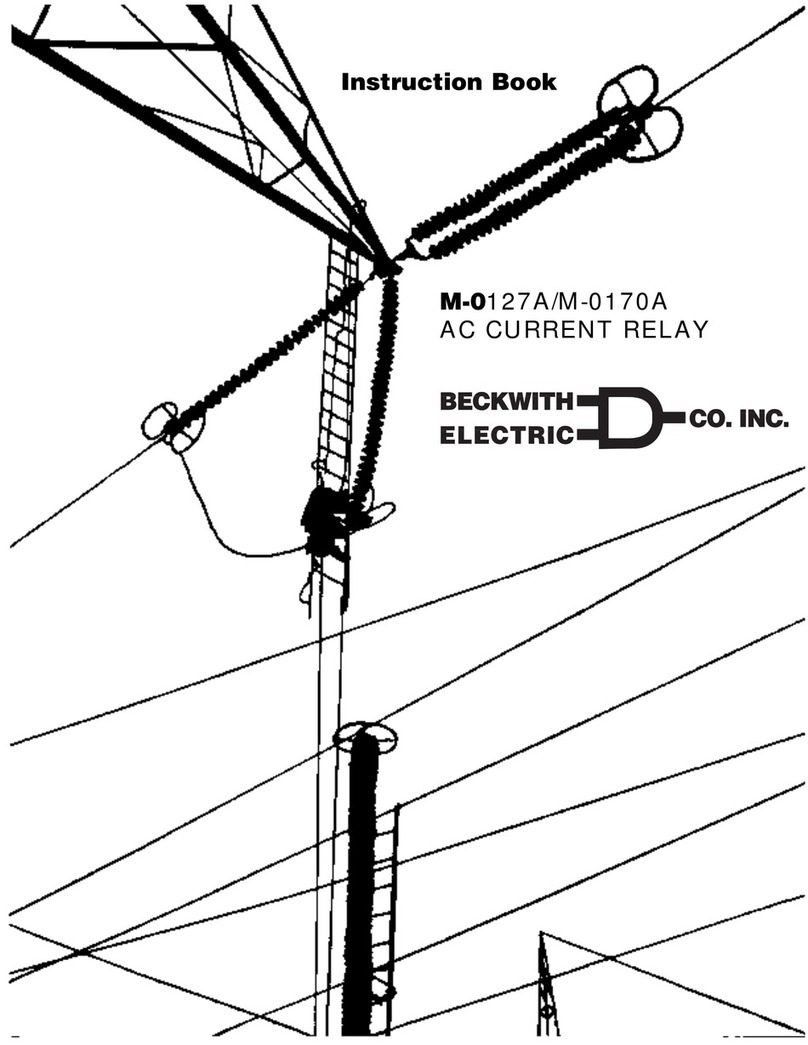
BECKWITH ELECTRIC
BECKWITH ELECTRIC M-0127A User manual

BECKWITH ELECTRIC
BECKWITH ELECTRIC M-0420 User manual

BECKWITH ELECTRIC
BECKWITH ELECTRIC M-3425A User manual
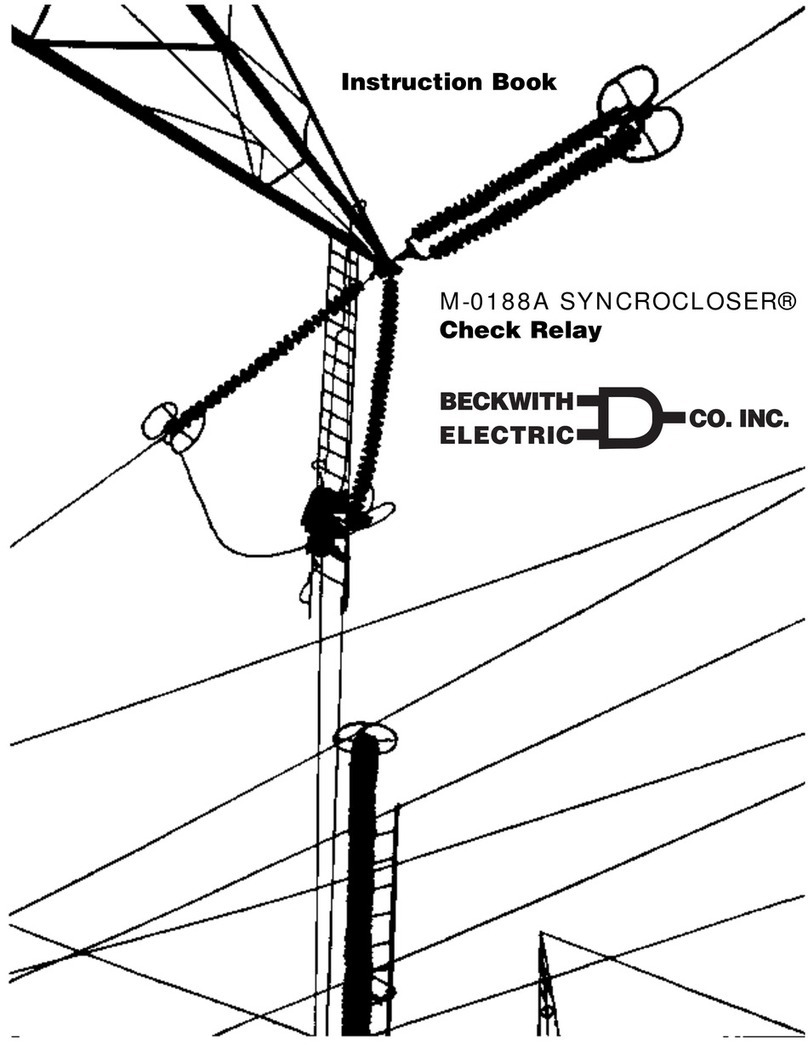
BECKWITH ELECTRIC
BECKWITH ELECTRIC SYNCROCLOSER M-0188A User manual

BECKWITH ELECTRIC
BECKWITH ELECTRIC M?3311A User manual

BECKWITH ELECTRIC
BECKWITH ELECTRIC M-3520 User manual

BECKWITH ELECTRIC
BECKWITH ELECTRIC M-0236B User manual
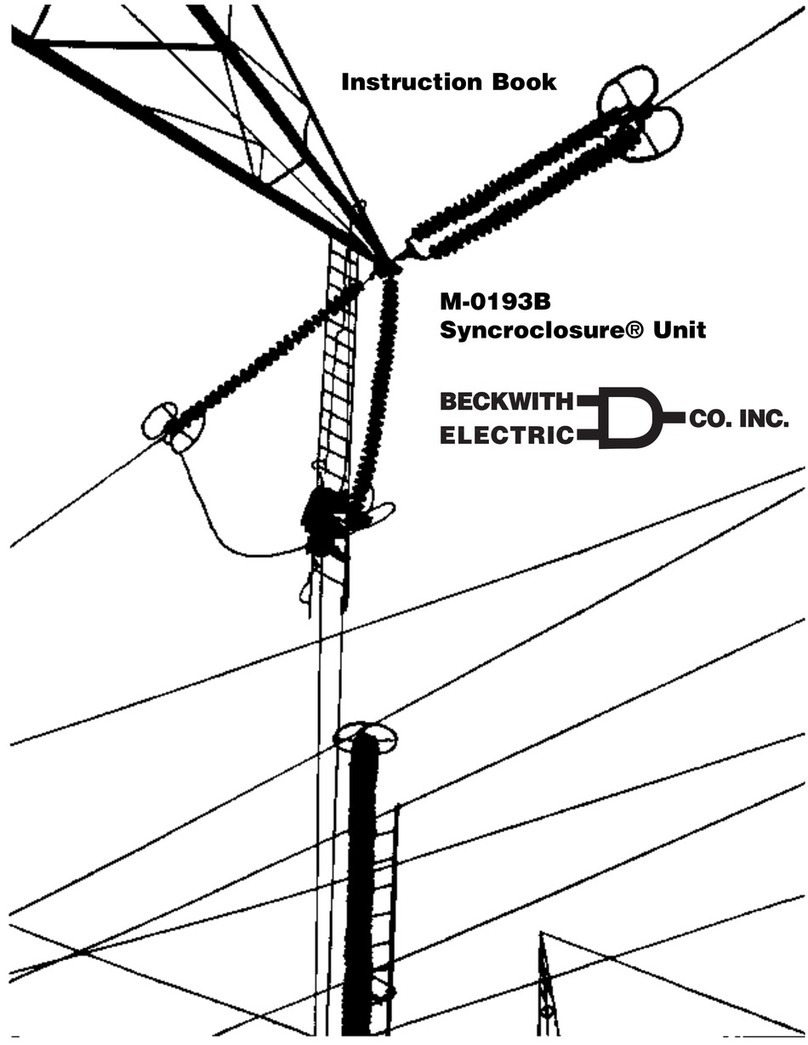
BECKWITH ELECTRIC
BECKWITH ELECTRIC Syncroclosure M-0193B User manual
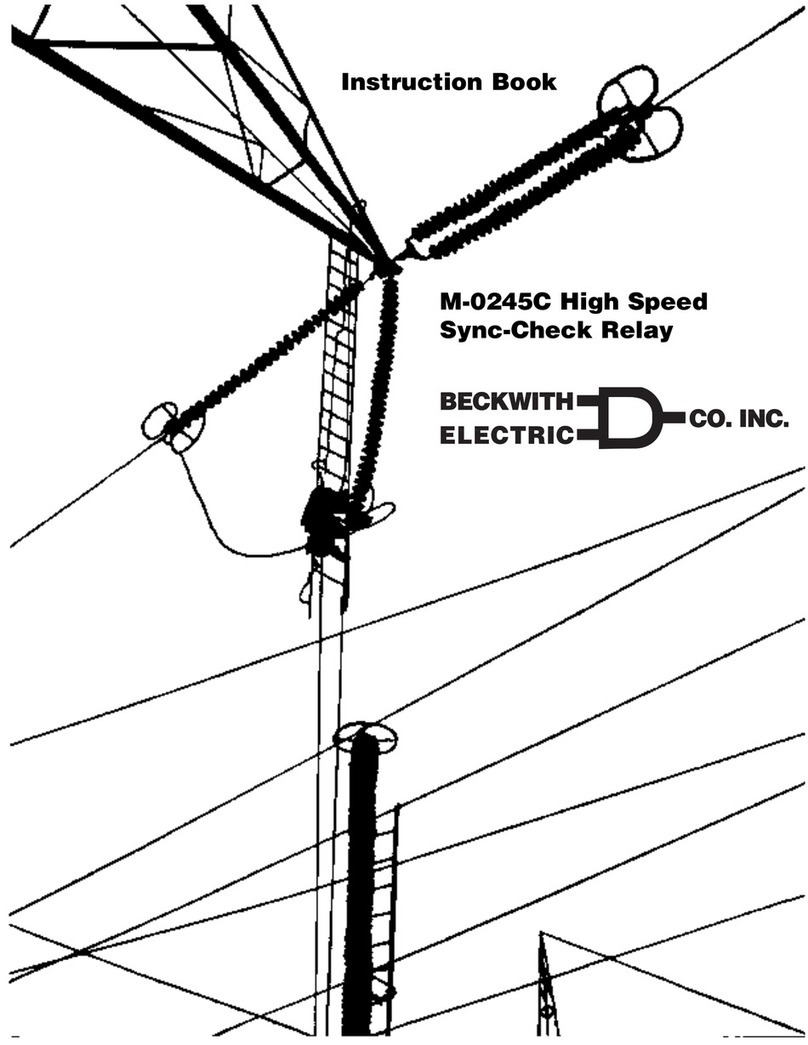
BECKWITH ELECTRIC
BECKWITH ELECTRIC M-0245C User manual
